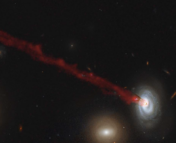Title: Possible observational evidence that cosmic filaments spin
Authors: Peng Wang, Noam I. Libeskind, Elmo Tempel, Xi Kang, Quan Guo
First Author’s Institution: Leibniz-Institut für Astrophysik Potsdam, Potsdam, Germany
Status: Published in Nature Astronomy [open access], available on arXiv
Galaxy clusters are huge objects, typically containing thousands of galaxies, each of which contains hundreds of billions of stars. However, there are structures in our Universe that are even larger than these giants. Cosmic filaments, fibres of matter that stretch between clusters, are truly vast. These huge strands can reach hundreds of millions of light years in length and form the cosmic web, an immense network that spans the Universe and carries galaxies into galaxy clusters.
Although we know that they play an important role in the formation and evolution of galaxies, much remains unknown about cosmic filaments themselves, and the property that the authors of today’s paper are interested in is their spin. Rotation is common in our Universe: planets orbit around stars, galaxies rotate, and we believe that dark matter haloes spin too.
So do filaments behave in the same way? Previous theoretical work has shown that, in simulations of the cosmic web, these long cylindrical filaments rotate along their axis (like a rolling pin). Now, for the first time, this rotation has been detected observationally!
Searching the sky for spinning strands
Today’s paper utilises a catalogue of cosmic filaments found using the Sloan Digital Sky Survey (SDSS). Filaments are not easy to detect though, and so these filaments were detected using an algorithm called Bisous, which finds linear structures in the distribution of galaxies. Bisous is actually an algorithm that was borrowed by astronomers — it was originally used to detect roads in satellite images of Earth!
Each of these filaments forms a rectangle on the sky, with a galaxy cluster (or galaxy group) at each end, and galaxies embedded within the filament. Splitting the rectangle in half lengthways, a rotating filament should result in galaxies in one half of the rectangle approaching us, and galaxies in the other half moving away from us. Imagine heating a delicious bowl of soup and croutons in a microwave: when the bowl is rotating, you would see croutons on one side of the bowl moving towards you, and those on the other side moving away. If you don’t like soup, Figure 1 instead shows a schematic diagram of a filament.

Figure 1: Schematic diagram showing a rotating filament between two clusters. The motion of the filament makes galaxies on one side move towards us, and galaxies on the other side move away (Figure produced by Roan Haggar).
Naturally, things are a little more complicated than this. Filaments themselves move relative to us, and galaxies also move around within filaments, meaning that even galaxies in a non-rotating filament would appear to be moving. To solve this problem, the authors use the redshifts of 213,625 galaxies in 17,181 filaments to work out their line-of-sight velocities (the speed at which each galaxy is moving towards or away from us), and then calculate the average difference in velocity of galaxies on each side of each filament.
They find that the difference in galaxy velocities on either side of the filaments is significantly greater than what we’d expect for non-spinning filaments, and so non-spinning filaments cannot explain their observations. Their detection is particularly strong in filaments that are perpendicular to the line of sight (so we can see the filament stretched across the sky), and in “cold” filaments (those in which the galaxies are not moving around as much). They also find stronger rotation in filaments with large clusters at their ends, indicating that their observations are due to gravity. Figure 2 shows their strongest rotation signal, for filaments that satisfy all three of these criteria.

Figure 2: Left: Rotation signal for “cold” filaments in the plane of the sky, with large objects at their ends (top 10% by mass). Top half of the plot is the side of each filament where the galaxies had a greater average redshift, corresponding to the receding edge of the filament (Figure 4i in today’s paper). Right: Rotation curve for filaments, showing the average rotation speed as a function of distance from the central filament axis (Figure 5 in today’s paper).
A solution to the secret source of spin?
The rotation of moons, planets, stars and galaxies shows us that angular momentum can be generated on a wide range of scales in space. But, angular momentum must be conserved — it can’t appear out of nowhere. The source of this momentum has long been a mystery, and searching for evidence of rotation on larger and larger scales is one approach to unveiling how this angular momentum is exchanged through the Universe.
Cosmic filaments are the largest rotating structures ever found. Their detection means that we have taken a step closer to understanding the ubiquity of spin in our Universe, but that we will need to search on ever-increasing scales in order to fully solve this problem. The authors summarise this in the final sentence of their paper: “angular momentum can be generated on unprecedented scales, opening the door to a new understanding of cosmic spin”.
Astrobite edited by Huei Sears
Featured image credit: AIP/A. Khalatyan/J. Fohlmeister



